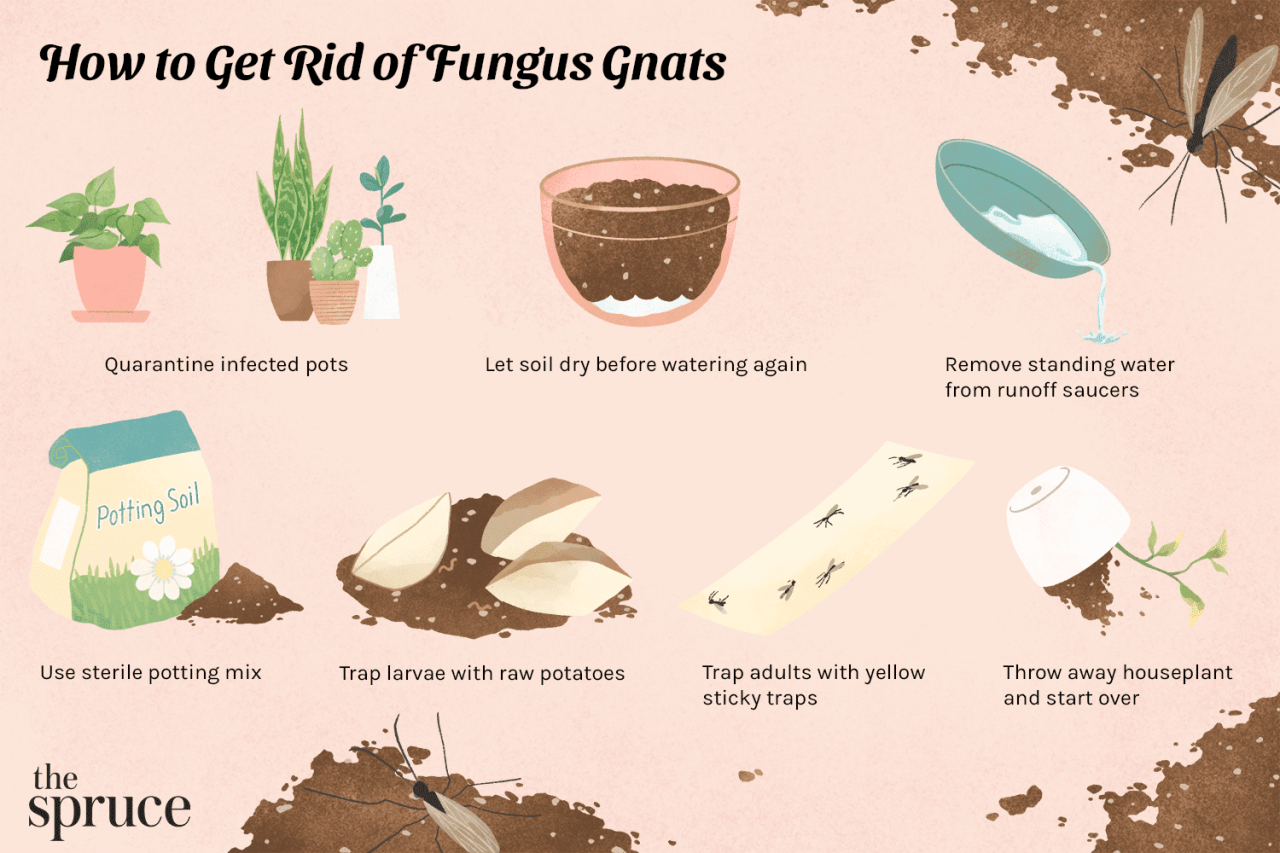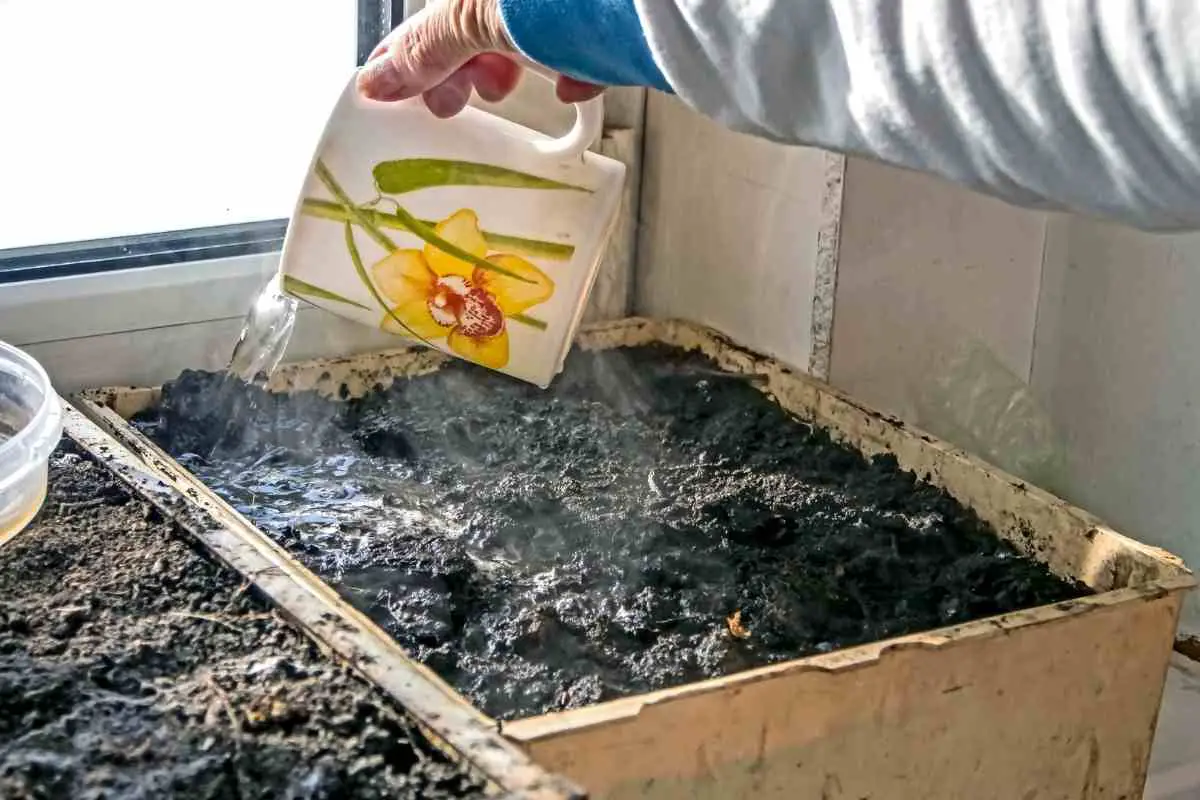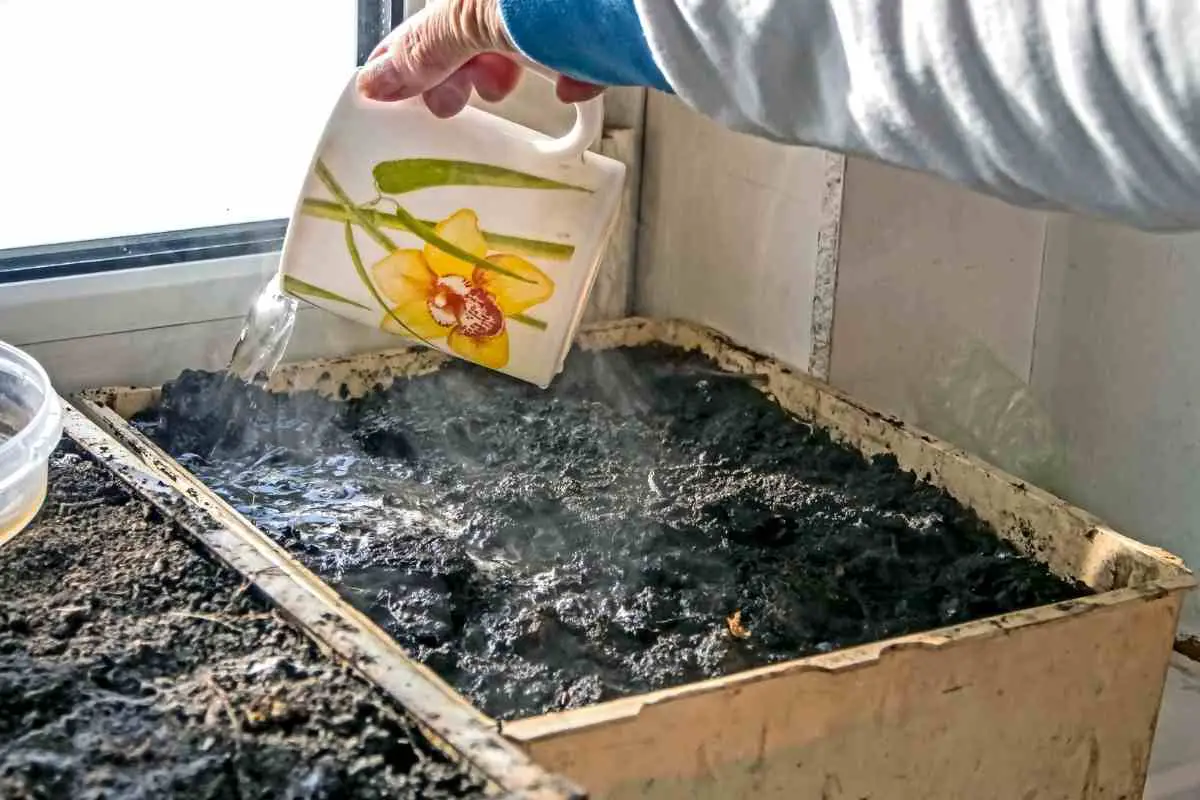How to Sterilize Soil to Avoid Gnats in Indoor Plants is a crucial step in maintaining the health of your indoor plants and preventing pesky gnat infestations. These tiny flies, often called fungus gnats, are attracted to moist soil and decaying organic matter, making indoor plants a prime breeding ground.
They can quickly multiply, causing damage to plant roots and leaving behind unsightly black specks on the soil surface. Sterilizing your soil before planting can effectively eliminate gnat larvae and create a less hospitable environment for them to thrive.
Understanding the life cycle of fungus gnats and the factors that attract them to your plants is essential for effective control. Sterilization methods like baking in the oven or using a microwave offer a safe and effective way to eliminate gnat larvae.
Beyond sterilization, maintaining proper watering practices and creating a less attractive environment for gnats can help prevent future infestations. This article will explore these methods and strategies to help you keep your indoor plants healthy and gnat-free.
Understanding Gnats and Their Life Cycle

Fungus gnats are tiny, black flies that are a common nuisance in indoor plant environments. They are attracted to the moist soil of potted plants and lay their eggs in the soil, where they hatch into larvae that feed on decaying organic matter.
Life Cycle of Fungus Gnats
Fungus gnats have a complete life cycle, which includes four stages: egg, larva, pupa, and adult. The life cycle typically takes 2-4 weeks to complete, depending on environmental conditions.
- Eggs:Fungus gnat eggs are small, white, and oval-shaped. They are laid in clusters in the soil, often near the surface.
- Larvae:The larvae are small, white, legless, and worm-like. They feed on decaying organic matter in the soil, such as dead roots and fungi.
- Pupae:The larvae eventually pupate, forming a hard, brown shell. The pupae are often found in the soil or on the surface of the soil.
- Adults:Adult fungus gnats are small, black flies with long legs. They are typically 1/8 to 1/4 inch long. Adult fungus gnats do not feed on plants but are attracted to moisture and decaying organic matter.
Signs and Symptoms of a Gnat Infestation, How to Sterilize Soil to Avoid Gnats in Indoor Plants
A gnat infestation can be easily identified by the presence of adult gnats flying around your plants. Other signs of a gnat infestation include:
- Small, black flies hovering around plants:This is the most obvious sign of a gnat infestation.
- Tiny, white worms in the soil:These are the larvae of fungus gnats.
- Yellowing or wilting leaves:This can be caused by the larvae feeding on the roots of your plants.
- Mold or fungus growth on the soil surface:This can attract gnats and create a favorable environment for their larvae.
Environmental Factors That Attract Gnats
Several environmental factors can attract gnats to indoor plants, including:
- Overwatering:Gnats are attracted to moist soil, so overwatering your plants can create a breeding ground for them.
- Poor drainage:If your plants are sitting in water, this can also attract gnats.
- High humidity:Gnats thrive in humid environments, so if your home is particularly humid, this can attract them.
- Organic matter in the soil:Gnats feed on decaying organic matter, so if your soil is rich in organic matter, this can attract them.
Sterilization Methods
Sterilizing soil before using it for indoor plants is an effective way to prevent fungus gnats from infesting your plants. By eliminating the gnats’ food source (fungi and decaying organic matter), you can significantly reduce the chances of an infestation.
Sterilizing your soil before planting can significantly reduce the chances of gnats invading your indoor plants. While this method helps prevent infestations, you may still encounter these pesky insects. If gnats are already present, consider using effective insecticides to eliminate them.
For a comprehensive guide on the best insecticides to tackle gnat infestations, check out this helpful article: The Best Insecticides to Get Rid of Gnats in Plants. Once the infestation is under control, remember to sterilize your soil to prevent future outbreaks and enjoy healthy, gnat-free indoor plants.
There are various methods for sterilizing soil, each with its advantages and disadvantages.
Soil Sterilization Methods Comparison
The effectiveness of each method varies depending on the type of soil, the severity of the infestation, and the time spent on the process.| Method | Effectiveness | Time Requirement | Potential Risks ||—|—|—|—|| Oven| Very effective | 30-60 minutes | Risk of burning soil if not monitored carefully || Microwave| Moderately effective | 1-2 minutes per cup | Risk of overheating and potential fire hazard || Boiling| Moderately effective | 30 minutes | Can leach nutrients from soil || Solarization| Moderately effective | 6-8 weeks | Requires sunny weather and ample space || Steam Sterilization| Very effective | 30-60 minutes | Requires specialized equipment |
Oven Method
This method is effective at killing most pests and pathogens in soil.
- Preheat your oven to 200°F (93°C).
- Spread the soil evenly on a baking sheet. Do not overcrowd the sheet.
- Place the baking sheet in the preheated oven and bake for 30-60 minutes, depending on the amount of soil.
- Stir the soil every 15 minutes to ensure even heating.
- Remove the soil from the oven and allow it to cool completely before using it for planting.
Microwave Method
Microwaving is a faster method, but it may not be as effective as oven sterilization.
Sterilizing soil is a crucial step in preventing gnat infestations in indoor plants. This process eliminates existing eggs and larvae, effectively cutting off the life cycle of these pesky insects. However, it’s also essential to address the root cause of the infestation, which often lies in the soil’s composition.
By improving the drainage and aeration of your potting mix, you can create an environment less conducive to gnat breeding. For a comprehensive guide on enhancing your soil to combat gnats, check out How to Improve Plant Soil to Reduce Gnat Infestations.
Once you’ve addressed the soil’s composition, sterilizing it becomes even more effective in preventing future infestations.
- Place a cup of soil in a microwave-safe bowl.
- Microwave on high for 1-2 minutes, checking the soil every 30 seconds.
- The soil should be steaming hot but not burning.
- Repeat the process for additional cups of soil, allowing the microwave to cool slightly between each cycle.
Caution:Be careful when microwaving soil. The soil can overheat and potentially cause a fire hazard. It’s best to microwave soil in small batches and monitor it closely.
Alternative Prevention Strategies
Beyond sterilization, several proactive measures can help deter gnats and create a less hospitable environment for them in your indoor plants. These strategies focus on minimizing the factors that attract gnats and promoting healthy plant growth, which naturally discourages pests.
Creating a Less Attractive Environment
Creating a less attractive environment for gnats involves addressing their basic needs, such as moisture, food, and breeding grounds. Here are some tips:
- Reduce Excess Moisture:Gnats are attracted to damp soil. Allow the top inch of soil to dry out between waterings. This helps prevent the buildup of excess moisture that gnats thrive on.
- Avoid Overwatering:Overwatering is a common cause of gnat infestations. Water your plants only when the soil is dry to the touch. Avoid letting water sit in saucers or trays, as this provides a breeding ground for gnats.
- Use Well-Draining Soil:Choose potting mixes that drain well to prevent waterlogging. A good mix will allow excess water to flow through, reducing the chances of gnats breeding in the soil.
- Remove Dead Plant Matter:Decaying plant material, such as fallen leaves and stems, can attract gnats and provide them with a food source. Regularly remove any dead plant material from your plants and the surrounding area.
- Clean Up Spills:Spilled water or other liquids on surfaces can attract gnats. Clean up spills promptly to prevent them from becoming breeding grounds.
Natural Pest Control
Natural pest control methods can help deter gnats without resorting to harsh chemicals. These methods often involve introducing beneficial insects or using plant-based solutions:
- Neem Oil:Neem oil is a natural insecticide derived from the neem tree. It disrupts the life cycle of gnats and can be applied as a spray to your plants. Neem oil is effective against both adult gnats and larvae.
- Diatomaceous Earth:Diatomaceous earth is a natural powder made from fossilized diatoms. It acts as an abrasive to the exoskeletons of gnats, causing them to dehydrate and die. Apply diatomaceous earth around the base of your plants, being careful not to get it on the leaves.
- Yellow Sticky Traps:Yellow sticky traps attract gnats and other flying insects. The bright yellow color is particularly attractive to gnats, and the sticky surface traps them. Place the traps near your plants to monitor gnat activity and catch any adults.
- Predator Mites:Certain types of predator mites are known to feed on gnat larvae. Introducing these mites into your plant environment can help control gnat populations. However, ensure the mites are suitable for your specific plant species and environment.
Proper Watering Practices
Proper watering practices are crucial in preventing gnat infestations.
- Water Thoroughly:When you water your plants, ensure the water reaches the roots thoroughly. This helps the plants absorb the moisture they need and prevents the soil from becoming too dry, which can encourage gnat breeding.
- Water Less Frequently:Allow the soil to dry out slightly between waterings. This helps to prevent the buildup of excess moisture that attracts gnats. The frequency of watering will depend on the type of plant and the environmental conditions.
- Bottom Watering:Bottom watering is a technique that can help prevent gnats by reducing the amount of moisture on the surface of the soil. To bottom water, place the pot in a sink or basin of water for a few minutes, allowing the soil to absorb water from the bottom up.
Ongoing Maintenance: How To Sterilize Soil To Avoid Gnats In Indoor Plants

Sterilizing soil is an essential first step in preventing fungus gnats, but it’s not a one-time fix. Ongoing maintenance is crucial to keep gnats at bay and ensure your plants thrive.
Monitoring Soil Moisture
After sterilizing soil, it’s essential to monitor its moisture levels closely. Gnats thrive in damp environments, so overwatering can quickly undo your efforts. Allow the top inch of soil to dry out between waterings. You can use a moisture meter or simply stick your finger into the soil to check its dryness.
Maintaining a Healthy Soil Environment
A healthy soil environment is key to preventing future infestations. Here are some strategies to consider:
- Use well-draining potting mix:Choose a potting mix that allows excess water to drain quickly. Avoid heavy, clay-based mixes that retain moisture.
- Avoid overwatering:Water your plants only when the top inch of soil is dry. Overwatering creates a breeding ground for gnats.
- Top-dress with sand or perlite:Adding a layer of sand or perlite to the top of the soil can improve drainage and discourage gnat activity.
- Repotting:If your plants are pot-bound, repotting them into larger pots with fresh, sterilized soil can help prevent future infestations.
Preventative Measures
Preventative measures are crucial for managing gnats long-term. These strategies can help keep your plants gnat-free:
- Yellow sticky traps:These traps attract and capture gnats, helping to control their population.
- Neem oil:Neem oil is a natural insecticide that can be sprayed on plants to kill gnats and their larvae.
- Mosquito dunks:These small, donut-shaped tablets contain Bacillus thuringiensis israelensis (Bti), a bacterium that is highly effective at killing gnat larvae.
- Diatomaceous earth:This natural powder is made from fossilized algae and can be sprinkled on the soil surface to kill gnats.
- Apple cider vinegar traps:A simple mixture of apple cider vinegar and a few drops of dish soap can create a trap that attracts and kills gnats.
Closing Summary
By understanding the life cycle of fungus gnats, employing soil sterilization techniques, and implementing preventative measures, you can effectively combat these pests and maintain the health and beauty of your indoor plants. Remember, a healthy soil environment is crucial for thriving plants, and sterilization is an essential step in achieving that goal.
With a little knowledge and effort, you can create a gnat-free haven for your indoor greenery.
Popular Questions
What are the signs of a gnat infestation?
Common signs include small, black flies hovering around your plants, tiny black specks on the soil surface, and yellowing or wilting leaves due to root damage.
Can I sterilize soil with boiling water?
While boiling water can kill gnat larvae, it can also damage the soil structure and potentially harm beneficial microorganisms. It’s not the most recommended method.
How often should I sterilize my soil?
Sterilizing soil before planting is generally sufficient. However, if you suspect a gnat infestation, you may need to sterilize the soil again.
What are some natural pest control methods for gnats?
Diatomaceous earth, sticky traps, and introducing beneficial nematodes can help control gnat populations.
Can I use the same soil for my plants after sterilization?
Yes, once the soil has cooled down completely, it is safe to use for planting.
